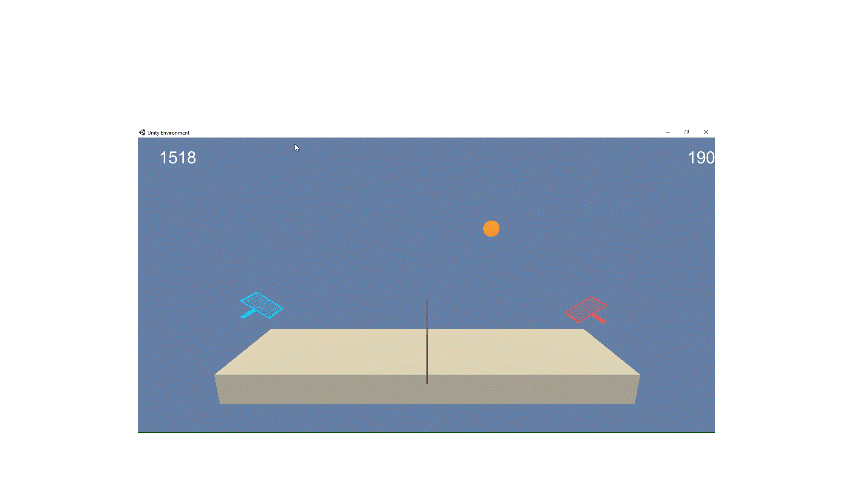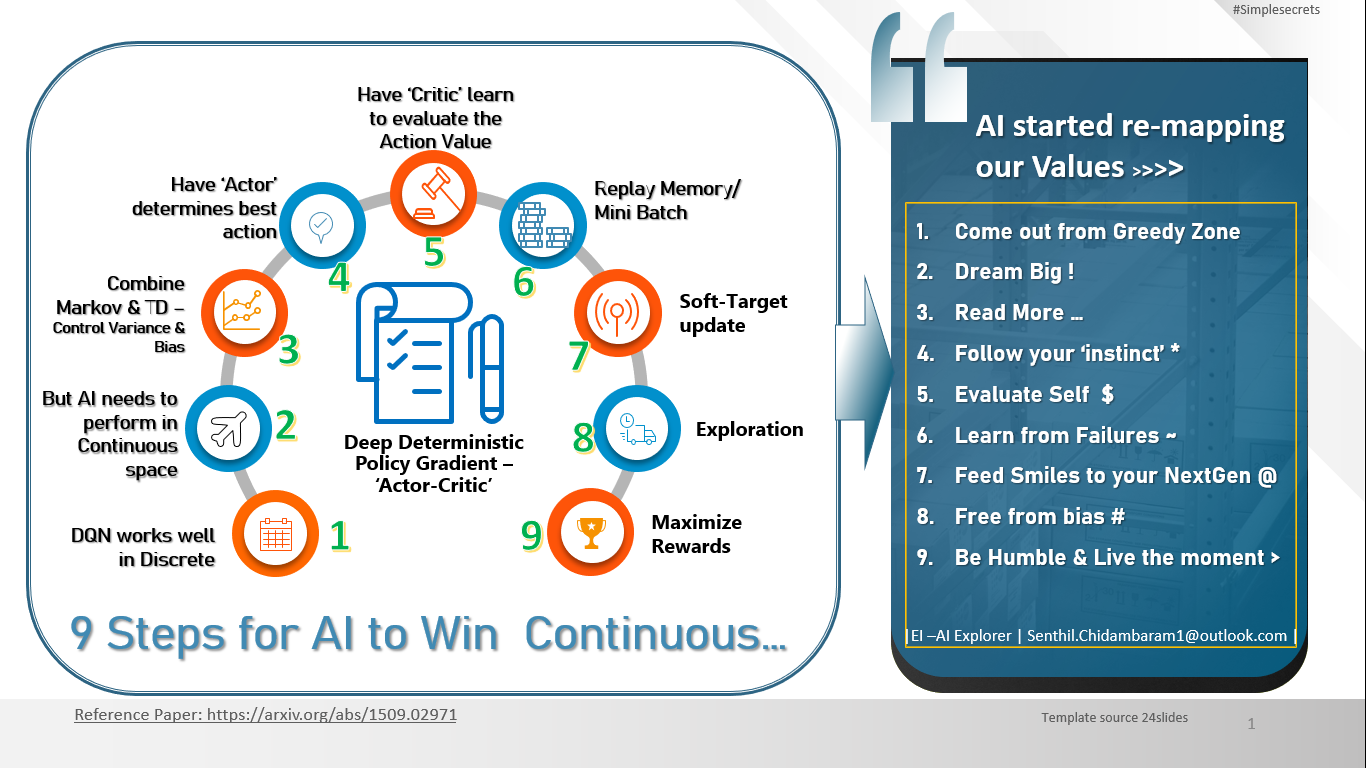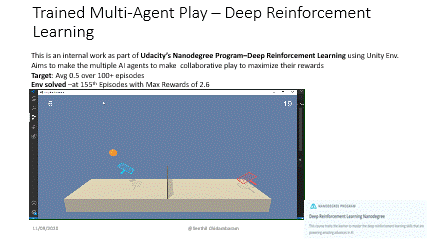Deep Reinforcement Learning (DRL) ,In simple , a mathematical way to clone the experiences start with trial and error (reward & punishment) approach to form a #digitalmemory (Policy with Critic) and take the best actions based on current situation to maximize the rewards like how a Toddler learn to play a Cricket motivated by 'high scorer' achievement.
This project simply help you to get the core of how AI works and detail implementation of Deep Deterministic Policy Gradients (DDPG) algorithm .
In this environment, two agents control rackets to bounce a ball over a net. If an agent hits the ball over the net, it receives a reward of +0.1. If an agent lets a ball hit the ground or hits the ball out of bounds, it receives a reward of -0.01. Thus, the goal of each agent is to keep the ball in play. The observation space consists of 8 variables corresponding to the position and velocity of the ball and racket. Each agent receives its own, local observation. Two continuous actions are available, corresponding to movement toward (or away from) the net, and jumping.
#HL Logic : Have common Actor-Critic Network and Replay Memory for collaboration between 2 AI agents to self-play in the given Tennis Envionment using DDPG algorithm
Trained Agents play:
while training around 25k episodes :
[Learning function called in end of each episode-Not on every step]

In this environment, two agents control rackets to bounce a ball over a net. If an agent hits the ball over the net, it receives a reward of +0.1. If an agent lets a ball hit the ground or hits the ball out of bounds, it receives a reward of -0.01. Thus, the goal of each agent is to keep the ball in play.
The observation space consists of 8 variables corresponding to the position and velocity of the ball and racket. Each agent receives its own, local observation. Two continuous actions are available, corresponding to movement toward (or away from) the net, and jumping.
The task is episodic, and in order to solve the environment, your agents must get an average score of +0.5 (over 100 consecutive episodes, after taking the maximum over both agents). Specifically,
After each episode, we add up the rewards that each agent received (without discounting), to get a score for each agent. This yields 2 (potentially different) scores. We then take the maximum of these 2 scores. This yields a single score for each episode. The environment is considered solved, when the average (over 100 episodes) of those scores is at least +0.5.
Develop an colloaborative AI Agents using 'actor-critic' methods - which should learn the best policy to maximize its rewards by taking best actions in the given continuous environment
- Final Report - Multi-Agent-DDPG-Tennis - DRL NanoDegree.pdf: Gives complete project implementation report with rewards plots with results
- Tennis.ipynb : Python Notebook "DDPG -Multi Agent Implementation given Unityenviornment -windows env"
- agent.py : Agent class and utilities like like Replay Memory and OUNoise (exploration)
- nn_model.py : Actor and Critic Neural Network Architecture (Feed forward
- DDPGMultiAgentTennis.py: Place holder for individual DDPG agents and common Replay Memory and Actor networks for both Agents
- HyperparamsConfig.json: Configuration for Hyperparameters and SEED
- Tennis.exe : Unity Environment for Windows- 64bit
- NN_WEIGHTS_EnvSolved: Saved Actor-Critic NN weights. (prev history saved models placed in ./NNWeights/)
- History.pdf: All Trial and Errors and Hyperparams tunings -Windows vs Udacity Workspace 10.Presentation_TennisAgentsPlay.pptx: Screen recording -Vidoe file of the TrainedAgents play
For Environment setup, you need Python 3.6, pytorch ,Ml-agents, Unity Environment to be installed. Once you setup your python environment , you just needs to have agent.py ,nn_model.py and Continuous_Control.ipynb if you wish to have quick hands-on .
- Anaconda Navigator - python 3.6
- PyTorch Example: conda install pytorch torchvision cudatoolkit=10.2 -c pytorch select right commands based on your OS , Python and conda/pip https://pytorch.org/get-started/locally/>
- Unity Environment https://github.com/Unity-Technologies/ml-agents/blob/master/docs/Installation.md
4.More detail on Ml-Agents https://github.com/Unity-Technologies/ml-agents/blob/master/docs/ML-Agents-Overview.md
5.Windows Env setup details - deprecated but may be useful https://hub.udacity.com/rooms/community:nd893:845401-project-503-smg-2/community:thread-12988088548-3621024?messageId=3652300&contextType=room
For the detail instruction please check https://github.com/udacity/deep-reinforcement-learning/blob/master/p1_navigation/README.md

